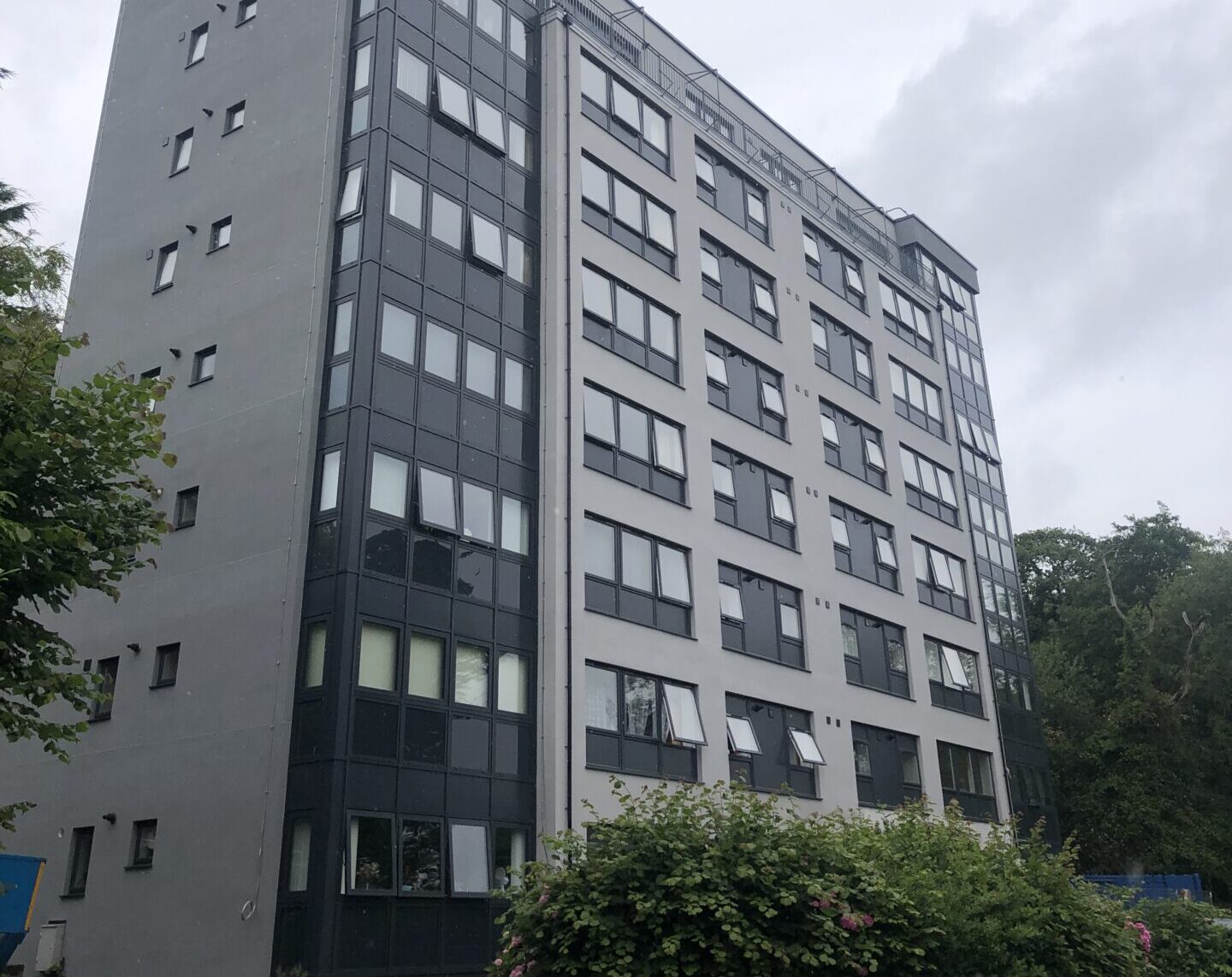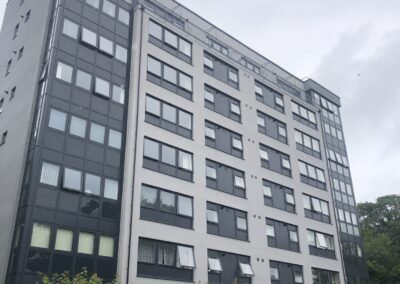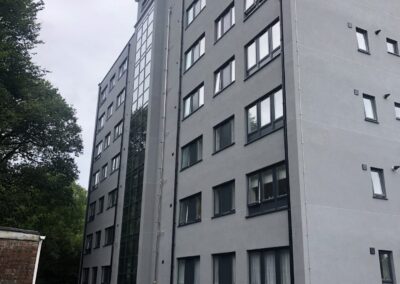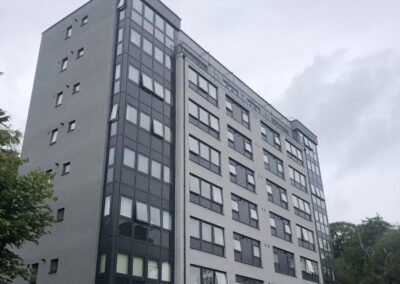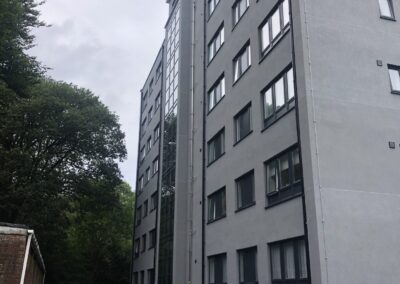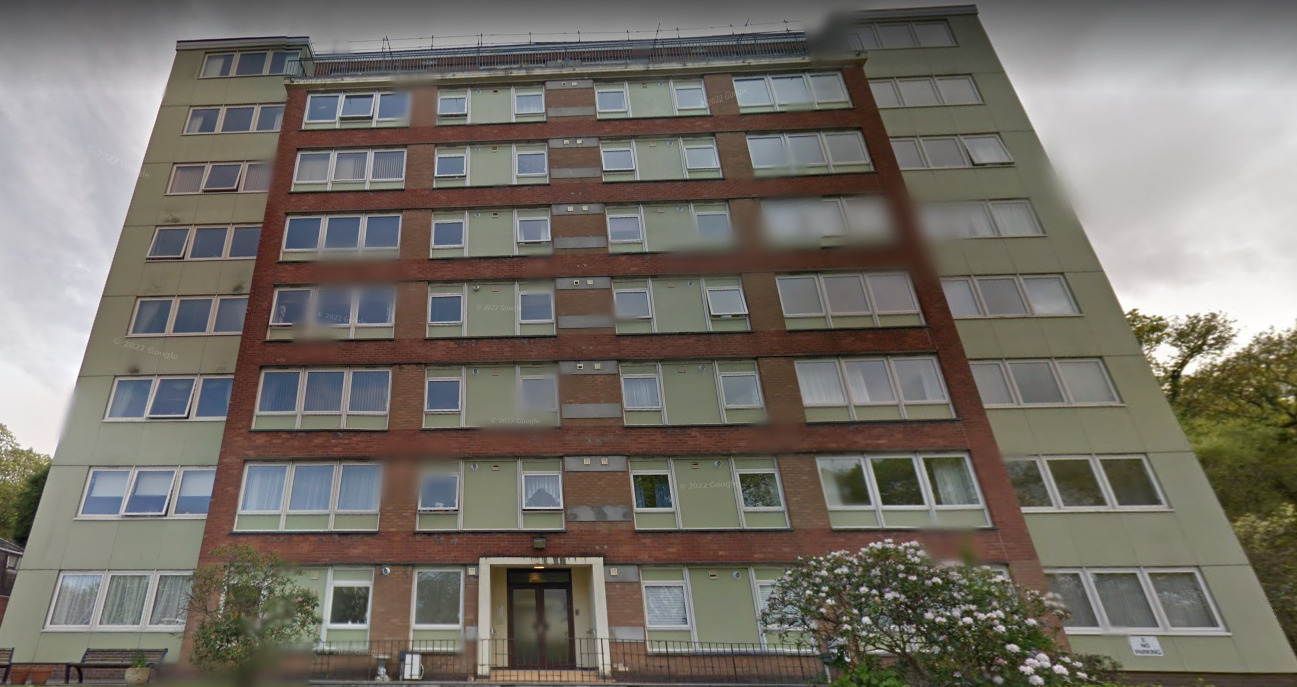INCA Case Study: Vivian House, Swansea
Vivian House, Swansea
Project Type: Refurbishment
Building Type: High Rise, Residential
Architect: N/A
System Designer: SPS Envirowall
Installer: SERS
System & Finish: SPSenvirowall Wall System 1 + Silicone Render
U-value Before: 1.37 W/m2k
U-value Achieved: 0.28 W/m2k
SPS Envirowall completed an ambitious EWI refurbishment project at Vivian House in Swansea’s coastal area, The Mumbles. Working with contractor SERS, on behalf of Pobl Housing Group, this major project was undertaken to transform the 1970s high-rise into a modern, sustainable living space for its tenants.
Vivian House, a landmark building located in the Mumbles, comprising 80 residential units spread across eight floors, has been home to hundreds of residents for over fifty years. Constructed with a traditional concrete frame, the rendered façade had degraded significantly over time, and SERS was initially appointed to renovate the building’s façade with a render finish, to prevent further deterioration.
Specific design, technical challenges overcome
Upon conducting comprehensive site surveys, it was discovered that the condition of the building envelope was worse than anticipated. Fundamental design flaws had resulted in structural cracks in the facade, as well as the failure of movement joints and deterioration of the brickwork. Determined to ensure the long-term viability of the properties, Pobl Housing Group engaged a structural engineer to work with SERS to develop solutions to address the building’s issues.
To achieve enduring remedial works and secure the property’s longevity, SERS proposed SPS Envirowall’s Wall System 1, a thin coat external wall insulation system, for its exceptional weathering and crack resistant properties. This was especially important in this exposed coastal location.
Although Pobl’s original budget did not allow for installation of an EWI system, the serious condition of the building, combined with EWI’s additional benefits of improved thermal efficiency and enhanced living conditions for residents, provided a compelling case to proceed with Wall System 1. The expanded scope also included the installation of a new insulated roof and the provision of new windows, doors, and curtain walling.
The Wall System 1 specification included dual density mineral wool insulation, Retrobase basecoat, and Granosil silicone topcoat. The system was mechanically-fixed The mineral wool insulation in slab form was bonded and mechanically-fixed through the glass-fibre reinforced basecoat layer to the masonry substrate, and finished with silicone topcoat.
Installation details, including challenges on site
The main installation challenges were the poor condition of Vivian House and minimising disruption to its residents. Prior to installing Wall System 1, it was necessary to repair any structural deficiencies identified in the technical assessment. A plan was created to ensure that the residents were allowed to remain in their homes throughout the twelve month project – from stripping the original cladding to completing the new EWI installation. This plan included a detailed communication strategy, scheduling the refurbishment activities in phases, as well as stringent health and safety measures.
Thermal performance enhancement
By installing Wall System 1, the property’s U-value was significantly improved from 1.37 W/(m²K). to an impressive 0.28 W/(m²K). This greater thermal efficiency helped to reduce heat loss through the walls, minimizing the reliance on heating and cooling systems – leading to lower energy consumption and cost savings.
Contributory factors such as design, location and aesthetics which make it a ‘stand-out’ project
Vivian House is considered a ‘stand-out’ project for several reasons. It underlined Pobl Housing Group’s commitment to maintaining resident safety and well-being, and has received positive feedback from residents about the improved living conditions and reduced energy bills. The refurbishment has modernised and refreshed the visual impact of Vivian House, increasing its overall value. Its enhanced ‘kerb appeal’ has contributed to the aesthetic appeal of the neighbourhood.
Completing such a challenging project, over a twelve month period, while allowing residents to remain in their homes was a major achievement, requiring significant collaboration between Pobl, SERS and SPS Envirowall.
By reducing thermal bridging and minimizing heat transfer, the system has helped to maintain a more consistent indoor temperature, leading to improved occupant comfort by eliminating cold spots, drafts, temperature fluctuations, and condensation, commonly experienced in older buildings such as Vivian House. The additional layer of insulation in the external wall system has also helped in reducing noise transmission from the outside. These enhancements have had a significant positive impact on resident wellbeing.
Wall System 1 has provided additional structural integrity to the building, improving its overall stability and durability, thereby extending its useful life.
Quotes from the client
“We are thrilled to complete this significant refurbishment project at Vivian House,” said Mr. John Evans, CEO of Pobl Housing Group. “Our aim was to create a more sustainable and comfortable living environment for our residents while reducing their energy costs. By investing in EWI and other energy-saving measures, we are not only improving the quality of life for our tenants but also contributing to a greener future for Swansea.”
Further feedback came from the Vivian House residents via their Newsletter, expressing praise for the way the project was carried out and, in particular, the responsiveness of the on-site team.
Our aim was to create a more sustainable and comfortable living environment for our residents while reducing their energy costs. By investing in EWI and other energy-saving measures, we are not only improving the quality of life for our tenants but also contributing to a greener future for Swansea.

